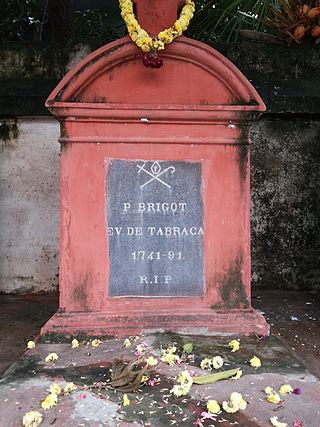Related Research Articles

The Barnabites, officially named as the Clerics Regular of Saint Paul, are a religious order of clerics regular founded in 1530 in the Catholic Church. They are associated with the Angelic Sisters of St. Paul and the members of the Barnabite lay movement.
Pyuntaza is a small town located in Nyaunglebin Township, Bago District, Bago Region, Myanmar. It is about 70 kilometres (43 mi) from Bago.

Bago, formerly known as Hanthawaddy, is a city and the capital of the Bago Region in Myanmar. It is located 91 kilometres (57 mi) north-east of Yangon.

Operation Dracula was a World War II-airborne and amphibious attack on Rangoon by British and Anglo-Indian forces during the Burma Campaign.

British rule in Burma lasted from 1824 to 1948, from the successive three Anglo-Burmese wars through the creation of Burma as a province of British India to the establishment of an independently administered colony, and finally independence. The region under British control was known as British Burma, and officially known as Burma from 1886. Various portions of Burmese territories, including Arakan and Tenasserim were annexed by the British after their victory in the First Anglo-Burmese War; Lower Burma was annexed in 1852 after the Second Anglo-Burmese War. The annexed territories were designated the minor province of British Burma in 1862.

The Catholic Church in Myanmar is part of the worldwide Catholic Church, under the spiritual leadership of the Pope in Rome. In 2020, there were approximately 700,000 Catholics in Burma - approximately 1.29% of the total population.

Shin Sawbu was queen regnant of Hanthawaddy from 1454 to 1471. Queen Shin Sawbu is also known as Binnya Thau or Old Queen in Mon. Queen Shin Sawbu and Queen Jamadevi of Haripunjaya are the two most famous among the small number of queens who ruled in mainland Southeast Asia.
Binnya Dala was the last king of Restored Kingdom of Hanthawaddy, who reigned from 1747 to 1757. He was a key leader in the revival of the Mon-speaking kingdom in 1740, which successfully revolted against the rule of Toungoo dynasty. Though Smim Htaw Buddhaketi was the king, it was Binnya Dala who was the prime minister that wielded power. After the nominal king abdicated in 1747, Binnya Dala, a local Mon nobleman with a Burman given name of Aung Hla, was elected king of the Mon-speaking kingdom.
Nanda Bayin, was king of the Toungoo dynasty of Burma (Myanmar) from 1581 to 1599. He presided over the collapse of the First Toungoo Empire, the largest empire in the history of Southeast Asia.
The Sieur de Bruno was a French adventurer and diplomat of the 18th century. He took an important role in developing French influence in Burma, and in leading French efforts at supporting the Mons during their conflicts against the Burmese.
M. Feraud was a French diplomat of the 18th century who went on a mission to resume official French East India Company contacts with Burma in 1769. He obtained a trade treaty, and the establishment of a French factory in the city of Rangoon.

France-Myanmar relations are the bilateral relations between Myanmar and France. Relations began in the early 18th century, as the French East India Company was attempting to extend its influence into Southeast Asia. France has an embassy in Yangon and Myanmar has an embassy in Paris.
Rail transport in Myanmar began in 1877. Three private rail companies were nationalised nineteen years later. During the Japanese occupation of Burma, Allied prisoners of war were forced to build the Burma Railway. Myanmar Railways has expanded its network somewhat since 1988.

The Second Anglo-Burmese War or the Second Burma War was the second of the three wars fought between the Burmese Empire and British Empire during the 19th century. The war resulted in a British victory with more Burmese territory being annexed to British India.

Kyansittha was king of Pagan dynasty of Burma (Myanmar) from 1084 to 1112/13, and is considered one of the greatest Burmese monarchs. He continued the social, economic and cultural reforms begun by his father, King Anawrahta. Pagan became an internationally recognized power during his 28-year reign. The Burmese language and culture continued to gain ground.

The Forty Years' War was a military war fought between the Burmese-speaking Kingdom of Ava and the Mon-speaking Kingdom of Hanthawaddy. The war was fought during two separate periods: 1385 to 1391, and 1401 to 1424, interrupted by two truces of 1391–1401 and 1403–1408. It was fought primarily in today's Lower Burma and also in Upper Burma, Shan State, and Rakhine State. It ended in a stalemate, preserving the independence of Hanthawaddy, and effectively ending Ava's efforts to rebuild the erstwhile Pagan Kingdom.
Sir Henry Thomas Godwin KCB (1784–1853) was a British officer. He fought in the British Army in the Peninsular War and in the First Anglo-Burmese War before joining the Bengal Army, in which he served as commander in chief of British and Indian forces in the Second Anglo-Burmese War of 1852 and 1853.
The military history of Myanmar (Burma) spans over a millennium, and is one of the main factors that have shaped the history of the country, and to a certain degree, the history of Southeast Asia. At various times in history, successive Burmese kingdoms were also involved in warfare against their neighbouring states in the surrounding regions of modern Burmese borders—from Bengal, Manipur and Assam in the west, to Yunnan (the southern China) in the northeast, to Laos and Siam in the east and southeast.

Pierre Brigot was a missionary of the Paris Foreign Missions Society and was the first Superior of Karnatic Mission headquartered at Pondicherry which later became the Archdiocese of Pondicherry and Cuddalore. He was the Superior from 30 September 1776 until his death. He was formerly the Vicar Apostolic of Siam in Thailand from 8 December 1755. After his death the Karnatic Mission was headed by Bishop Nicolas Champenois.

The First Toungoo Empire was the dominant power in mainland Southeast Asia in the second half of the 16th century. At its peak, Toungoo "exercised suzerainty from Manipur to the Cambodian marches and from the borders of Arakan to Yunnan" and was "probably the largest empire in the history of Southeast Asia." The "most adventurous and militarily successful" dynasty in Burmese history was also the "shortest-lived."
References
- ↑ "The Burmese Empire a Hundred Years Ago, as Described by Father Sangermano, with an Introduction and Notes by John Jardine". World Digital Library. Retrieved 26 May 2013.
- ↑ Charles William Russell; Giuseppe Gaspare Mezzofanti (card.) (1863). The life of cardinal Mezzofanti; with an intr. memoir of eminent linguists, ancient and modern. Longman, Green, Longman, Roberts, & Green. p. 269 . Retrieved 31 May 2013.
- 1 2 3 Sangermano, Father (1833). William Tandy (trans.) (ed.). A Description of the Burmese Empire. Oriental Translation Fund of Great Britain and Ireland. pp. iii–iv. Retrieved 21 November 2010.
- ↑ Tondini di Quarenghi, Cesario (1907). "Barnabites". Catholic Encyclopedia . Robert Appleton. Retrieved 22 November 2010.
- ↑ Sangermano, Father (1893). "Preface to the first edition (1833)". In John Jardine, Nicholas Patrick Wiseman (ed.). The Burmese empire a hundred years ago. A. Constable. pp. xxxvii–xxxix. Retrieved 17 October 2013.
- 1 2 Sangermano, Father (1893). John Jardine, Nicholas Patrick Wiseman (ed.). The Burmese empire a hundred years ago. A. Constable and company. pp. 25 . Retrieved 17 October 2013.
- ↑ Sakhong, Lian H. (2003). In search of Chin identity: a study in religion, politics and ethnic identity in Burma. Nordic Institute of Asian Studies. p. 109. ISBN 978-0-7007-1764-4.
- 1 2 Fytche, Albert (1878). Burma past and present. C. K. Paul & co. pp. 196–97.
- ↑ Rajah, Ananda (2008). Remaining Karen: A Study of Cultural Reproduction and the Maintenance of Identity. Anu E Press. pp. 4–5. ISBN 978-1-921536-11-3.
- 1 2 Scott, James George (188). The Burman: his life and notions, vol. 2. Macmillan. pp. 89–90.
- 1 2 Valery, Antoine Claude Pasquin (1839). Historical, literary, and artistic travels in Italy: a complete and methodical guide for travellers and artists. Baudry. p. 493.
- ↑ Sangermano, Father (1893). "Preface to the second edition (1884)". In John Jardine, Nicholas Patrick Wiseman (ed.). The Burmese empire a hundred years ago. A. Constable. pp. xxxiii–xxxvi. Retrieved 17 October 2013.
- 1 2 St. John, R.F.St.A. (1893). "Notices of books: Description of the Burmese Empire". Journal of the Royal Asiatic Society : 901–902.
- ↑ He is cited, for instance, in vol. 48 of Harper's Magazine (Alden, Henry Mills; Hartman, Lee Foster; Wells, Thomas Bucklin; Allen, Frederick Lewis (December 1873 – May 1874). "Rev. of Frank Vincent, The Land of the White Elephant". Harper's Magazine . Retrieved 22 November 2010.) and in James George Frazer's The Golden Bough ( Frazer, James George (1913). The golden bough: a study in magic and religion, Volume 9. Macmillan. p. 175. Retrieved 22 November 2010.).
- ↑ Richell, Judith L. (2006). Disease and demography in colonial Burma . NUS Press. pp. 9, 138, 11, 171. ISBN 978-9971-69-301-5.